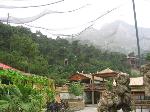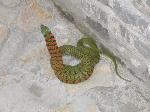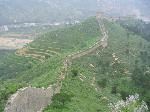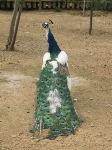- Getting around Lijiang. Dont stay in the Old Towns more than 2 days, there is nothing to do. KRISS Oct 9, 2013 05:46
- 2013 Beijing Temple Fair BENNYLAU Feb 26, 2013 03:29
- Malaysian traveling from KUL - LAX vis Shanghai PVG ZATI_DY Jan 3, 2013 20:15
Seeing the Sights in Shanhaiguan
- Views: 5406
- |Vote: 0 0
- |Add to Favorites
- |Recommend to Friends
Shanhaiguan: The Train Station & Less Than 250RMB
A last minute decision and I’d found myself at Shanhaiguan [山海关] Station with less than 250RMB in my pocket.
I couldn’t fault the 2-hour journey here on the double-decked and super-smooth T12 train, except perhaps I’d have loved a seat on the top deck. With carpet underfoot, cushioned seats and sharply dressed staff it’s easily the most luxurious train journey I’ve taken to date.
Certain I didn’t have enough money to stay the night at Shanhaiguan and secure transport home, my first port of call was the ticket office where I found myself buying a ticket for that old familiar K27 to Benxi. Night trains are a blessing, taking care of both transportation and accommodation simultaneously, and a hard sleeper usually guarantees a good night’s sleep.
Travelling is often about making compromises, so this night I would give up comfort and rest for the hope of a more thorough sightseeing exploration of Shanhaiguan. My limited funds saw me opting for a hard seat ticket and later I would join the ranks of students trying to doze as the night hours slipped slowly past. First though, I was determined to make the most of my limited time in this town.
Shanhaiguan used to be a garrison town and the old wall is still very much in evidence, visible from the train station in dark and crumbling brick. Inside the walls there’s a village feel that seems to deny for a while that this is the 21st Century and hangs on to its past despite the odds. It is, of course, very poor: the houses are low slung, ramshackle affairs that seem on the brink of collapse. Beyond the walls and back to reality, the city grows outwards and upwards in typical Chinese fashion.
Shanhaiguan’s train station is unlike any I have been to in China, and I like to think I’ve been to a few! It stands alone: clean and new and silent. There’s not a shop or street seller in sight and nowhere to stock up on the staple foods of train travel. A few maroon taxis and cars lingered outside, unhopeful and forlorn.
So it was, as I contemplated the absence of pot noodles, that a woman approached me with a laminated card of tourist sites and the offer of a taxi to hire for 50RMB: no time limits and no distance limits. I usually turn down such offers, but it turned out to be a blessing I didn’t as with my limited funds and the help of the driver I chose a 3 destination itinerary which would give me, I hoped, a sense of Shanhaiguan.
The First Pass Under Heaven [天下第一关]
Having established I couldn’t afford the entrance ticket the driver offered to take me to a spot where I could take a photo and get a glimpse of this Ming Dynasty built gate. Located within the old city walls, the driver stopped at a huge pile of rubble that was clearly a house until quite recently. Across the road was the entrance and in the distance was the ‘First Pass Under Heaven’ itself, a flag-topped reminder of 4 centuries earlier when the Manchus stormed it and began their reign in China.
I was sad that I would be unable to appreciate its former significance but interested to see how time has relegated it. Today it appears in the background of many a picture as tourists climb the pile of rubble to make the most of this free photo opportunity.
A Safari Park for Birds
Taking a drive out of the city and into the marvellous countryside of Shanhaiguan is definitely worth doing. Getting to this section of the Great Wall took me past the first orchards I’ve seen in China and up into rich green hillsides: pleasures in themselves.
I’ve been careful to avoid zoos and similar attractions in China. I’m not happy seeing animals in captivity in general and some of the small zoos I’ve stumbled across by accident have only left me feeling rather depressed. However, I was surprised to discover the huge bird park that has been set up here at the foot of the Great Wall. I wouldn’t call it a zoo as such, it’s more like a safari park for birds.
Entered through a gateway of thick and heavy chains, the park sprawls enclosed by a fine green net that just seems to have been thrown over this section of hills and forest, it makes you feel as though you’re walking in an enormous tent. Aside from the grounds staff, I think I was the only person there. I wandered the narrow, plant-lined trails and delighted at the peacocks that browsed the paths ahead of me or perched with their vivid-feathered pride on rocks or wooden posts.
Dozens of white cranes perched in the top of the tall coniferous trees, they seemed upright and serious. Occasionally one would spread its wings and soar effortlessly down. Numerous emus (fortunately) fenced regarded me with beady black eyes and curled their long necks curiously towards me. Black and white swans floated lazily around the ample pools and ducks snuggled their heads lazily beneath their wings, emitting a satisfied ‘quack’ from time to time.
Tunnels and A Snake
The birds are not the only feature of this park though. Cut into the surrounding rock are two substantial tunnels, each measuring approximately 1km in length. Dark, damp and cold, they’re remarkably authentic recreations of the tunnels that ran beneath the Great Wall providing an insight into what it must have been like to live and work here. Various caves lead off from the tunnels where you can explore the old kitchens, wells, storehouses, sleeping quarters and general’s offices. There are some signs with English translations. One states that up to 3000 soldiers would have been stationed in this 2km stretch! I imagined I could hear their boots and shouts echoing…
There are a couple of displays of weapons and implements of torture. The signs are all in Chinese but it’s not difficult to imagine the pain they are capable of inflicting. In other caves, scenes have been recreated, from a serene temple to a captured soldier being interrogated. It’s a sobering and eerie experience to walk in the gloom and imagine the discomfort and fear that must have characterised the everyday life of these soldiers who once guarded China.
It was a not unwelcome exit from the first tunnel into the brightness and heat of the afternoon. It was at this point that I encountered the snake, which somehow managed to neatly straddle the path. Initially I remained rooted to the spot as I tried to remember what course of action should be taken with snakes. The metre-length green with a large patch of red snake looked at me and hissed. Eventually I decided to run past it but not before I’d taken a couple of photos.
The 9 Gates Great Wall [九门口长城]
Finally I made my way to the Great Wall and I am always struck with a sense of awe whenever I glimpse it. This was my second venture onto its length and here it stretches for a short 1.5km before stopping abruptly at the tree-scaped cliffs. The first kilometre has been rebuilt and climbs in clean, deep grey-stoned steps. The real joy is the last 500m or so that is the steepest section and has remained in its original state. The stone is pale orange and plants have overgrown it completely whilst the watchtowers are low-walled ruins of themselves.
The wall rises up into the steep-sloped mountains, and the scenery unfolds in misty grace, revealing the regular-ridged terraces and squares of farmers’ fields and a narrow blue river down in the valley. On the opposite hills the Great Wall continues its familiar watchtower-punctuated path up and over the tops and beyond my sight. I sit for a while, enjoying the absence of tourists, and watching the white mountain goats nimbly negotiating the precipitous cliffs.
At the foot of the wall a group of old woman sat with large baskets of plums and peaches at their feet. They’d thrown their grumpy stares at me earlier when I’d declined to buy but were happy enough when on the way back to my taxi I couldn’t resist. A whole basket (a few kilos) for 7RMB and I was secretly hoping they’d give me the basket to carry them in but the lady pulled out a plastic bag and decanted the plums with a grin.
I wasn’t sure I’d be able to eat so many plums, but they were delicious and perfect for slurping in the late afternoon heat. The driver was happy to share on the way to my final destination.
Old Dragon Head [老龙头]
Originally, Old Dragon Head must have been a majestic conclusion to a Great Wall with nowhere left to go but the sea. Today, the 1980s re-constructed wall is enclosed as part of a tourist centre with an entrance ticket I couldn’t afford. The taxi driver obligingly took me to a nearby beach just a few hundred meters further on and told me to walk back along the beach towards the wall.
The beach was reasonably clean and stretched a long arc into the distance dissolving in a haze of cranes and industry. A few figures bobbed in the waves and many more relaxed on the sand. I turned my attention to the almost deserted narrow end of the beach and walked back towards the site of Old Dragon Head.
Looking not unlike the ramparts of an old castle, with a few flags flying, the Great Wall descends the slight slope and ends abruptly in the sea. It was possible to make out a few people walking on the section but I couldn’t help wondering if it was worth the price. I was content to be seeing this site from the beach with the sand and sea between my toes and from a distance where I could allow my imagination to believe, if just for a moment, that this was the real thing.
An Evening In Shanhaiguan
With a few hours until my train home I decided to wander around the town. Having eaten nothing but plums, I stopped at a street vendor to try some hot and spicy sausages, by coincidence it turns out the vendor came from Benxi.
I moved on to another street food stall selling cold noodles, the perfect food for a humid evening. The owners were friendly and told me they slept in the small 1-man tent erected nearby on the pavement.
Attracted by some nearby music I walked over to watch a group of 50 or so locals dressed in costume and performing a folk dance. One observant lady in the group must have spotted me and rushed over, she took off her gown and gestured for me to wear it simultaneously sticking her hat on my head. She then gave me her fan and pushed me off towards her partner who was continuing the dance.
I had no idea what to do, so I flapped my fan and shimmied my robes and tried my best to follow the moves of the others. The large crowd of locals with their children obviously enjoyed watching the crazy foreigner trying to figure things out and as it came to an end 5 (very long!) minutes later, there was much clapping and laughter.
Relieved to have made it without dropping the elaborate hat that was a little too small for my head, I returned the robes to the lady before I could be cajoled into another round.
The streets had been hung with fairy lights giving the town a relaxed, holiday atmosphere. A night market winding around several streets kept me thoroughly entertained before at last I was tempted to rest by an ice-cream seller. The fruity 1RMB bowl of sorbet was refreshingly cool.
With only an hour to go I made my way back towards the train station stopping for one last bite to eat from the Benxi vendor. A couple who had stopped there came to join me, the wife was an English teacher and the husband wanted me to drink beer with him. He was over 50 but looked remarkably young, and as I parted he told me his 5 secrets: drinking, smoking, dancing, singing and playing Mahjong.
Sleepless on the K27
My hard-seat ticket, as expected, guaranteed me a sleepless 7 hours home. I played cards, chatted a little and shivered as the blasting air-conditioning slowly froze us. About half way through the night the air-conditioning was turned off and for the rest of the journey we slowly roasted. It was with some relief I stepped out into the already warm Benxi morning, 5am, and made my way to the exit. Jumping into a taxi home and watching the meter running I prepared to spend my last 10 kuai.
Information (July 2006)
Getting There & Getting Back
From: Jinzhou to Shanhaiguan
By: Train T12 (double-decker)
Cost: 29RMB (seat)
Time: 2 hours
From: Shanhaiguan to Benxi
By: Train K27
Cost: 70RMB (hard seat)
Time: 7 hours (overnight)
Taxi to the 3 sights listed cost 50RMB. He waited for me for about 5 hours. This seems a pretty good price, I suspect because there was no-one else around!
The First Pass Under Heaven
Entrance Fee: 30RMB
The 9 Gates Great Wall
Entrance Fee: 90RMB
Includes: Bird Park, Tunnels & Great Wall
Old Dragon Head
Entrance Fee: 50RMB










 Copyright © 1998-2025 All rights reserved.
Copyright © 1998-2025 All rights reserved.
1.
Jul 30, 2006 02:50 Reply
RITA said:
Enjoyed reading your writing, as always! thanks for sharing!